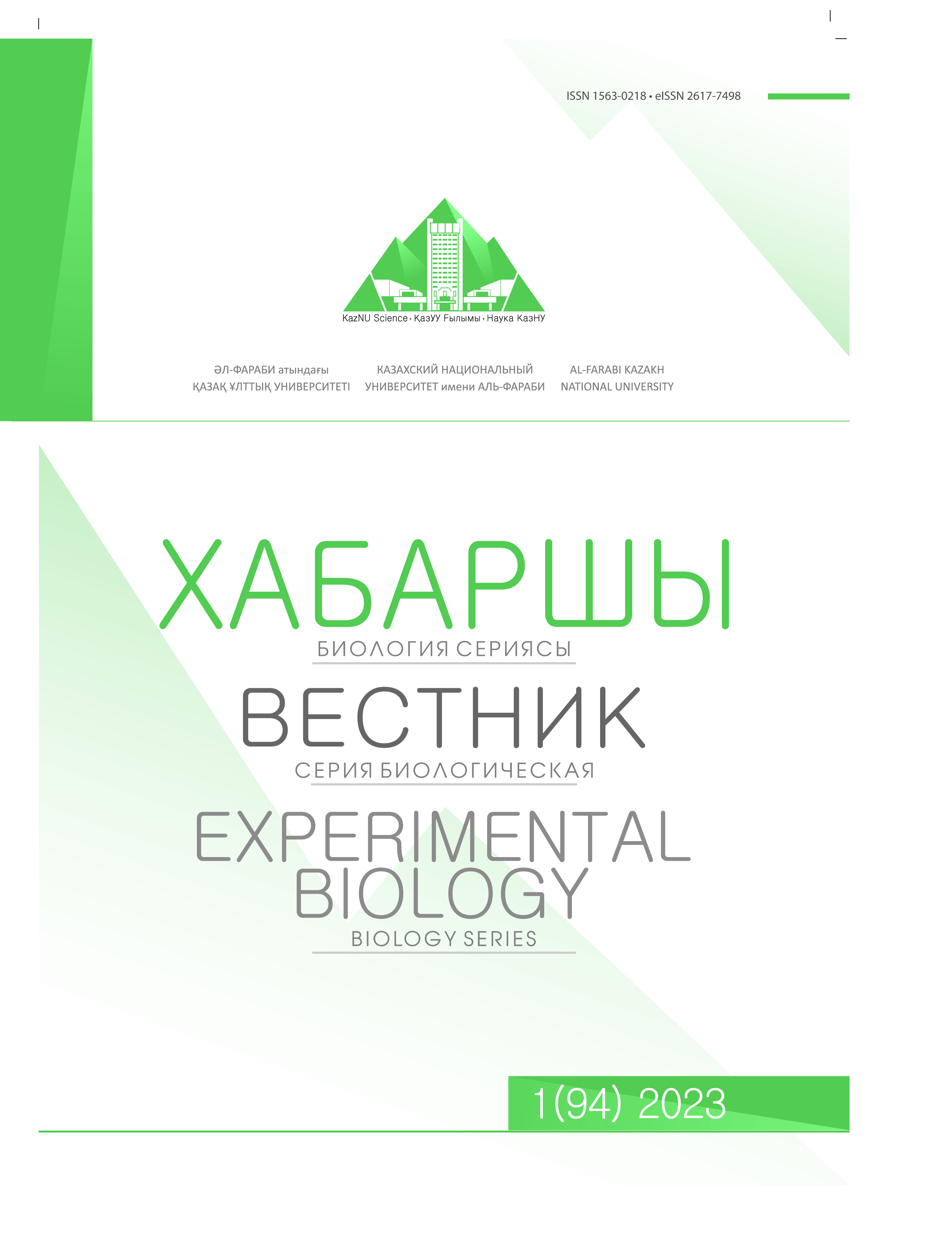CHARACTERIZATION OF FUNCTIONAL AND MICROBIAL PROFILE OF WHEY RECOVERED FROM COTTAGE CHEESE AND CHEESE MANUFACTURING
DOI:
https://doi.org/10.26577/eb.2023.v94.i1.05Keywords:
milk whey, fermentation, yeasts, whey microfloraAbstract
The main reason for selecting whey as a substrate of research and raw material for alcohol production is to reduce industrial waste that adversely impacts the environment, as well as to make a profit on it. The environmental impact of whey is related to its biological oxygen demand (BOD = 230 mg/ml) and chemical oxygen demand (COD = 70 mg / ml). Whey is mainly composed of disaccharide lactose, and the activity of yeast strains plays an important role in its conversion to bioethanol. Lactic acid bacteria, whey composition, and fermentation conditions also play an important role. In this work, the physicochemical properties of milk and cheese whey were studied, and microbiological analysis was carried out. The results show the high quality of the whey of the two selected producers of cottage cheese and cheese. The uniformity of consistency and normal appearance, taste, and smell, corresponding to the whey, testify to the observance of all sanitary norms and rules at the stage of whey collection. No significant differences were found between the characteristics of two different whey samples. The cells of yeast strains isolated from whey had different natures. 4 strains of alcohol-resistant yeasts and 2 strain of lactic acid bacteria Lactobacillus plantarum W1 and Leuconostocmesenteroides W1 were isolated, which could be promising biocatalysts for bioethanol production.
References
Apostolidis E., Kwon Y. I., Ghaedian R., Shetty K., Fermentation of Milk and Soymilk by Lactobacillus bulgaricus and Lactobacillus acidophilus Enhances Functionality for Potential Dietary Management of Hyperglycemia and Hypertension // Food Biotechnology. – 2005.- Vol.19. -P. 217-237.
BigDye® Terminator v3.1 Cycle Sequencing Kit Protocol Applied Biosystems, USA
Birch, R.M. and Walker, G.M. Influence of magnesium ions on heat shock and ethanol stress responses of Saccharomy- ces cerevisiae // Enzyme Microbiology Technology. – 2000. -Vol. 26. – P. 678-687.
Blaschek K.M, Wendorff W.L, Rankin S.A. Survey of salty and sweet whey composition from various cheese plants in Wisconsin // Journal of Dairy Science. – 2007. -Vol. 90, No 4. – P. 2029-2034.
Corsetti A., Valmorri S., Lactic Acid Bacteria. Lactobacillus spp.: Lactobacillus plantarum // Encyclopedia of Dairy Sci- ences. – 2011. – P. 111-118
Drozdova E. A., Popov V. P., Zinyukhin GB, Kasperovich V. L. The problem of rational use of secondary raw materials in the dairy and grain processing industry // Bulletin of the Orenburg State University. – 2013. – P. 99-103.
Ghanadzadeh, H., & Ghorbanpour, M. Optimization of Ethanol Production from Cheese Whey Fermentation in a Batch- Airlift Bioreactor // J Bioengineer & Biomedical. – 2012. – Vol.2.
Hidzir N.S., Som A.S., Abdullah Z. Ethanol production via direct hydration of ethylene: a review // International confer- ence on global sustainability and chemical engineering (ICGSE). – 2014.
Horwitz, William, and George L.W. Official Methods of Analysis of Aoac International // AOAC International. – 2005.
Kechkar M., Sayed W., Cabrol A., Aziza M., Ahmed Z., T., Amrane A., Djelal H. Isolation and identification of yeast strains from sugarcane molasses, dates and figs for ethanol production under conditions simulating algal hydrolysate // Brazilian Journal of Chemical Engineering. – 2019. -Vol. 36, No 1. – P. 157-169.
Kumar, R & Shankar, T. & Kasirajan, Anandapandian. Characterization of alcohol resistant yeast Saccharomyces cere- visiae isolated from Toddy // International Research Journal of Microbiology. – 2011. -Vol. 2, No 10. – P. 399-405.
Matsumoto T, Sugano M. 16S rRNA gene sequence analysis for bacterial identification in the clinical laboratory // Rinsho Byori. – 2013. – Vol.61, No 12. -15 p.
Outinen M., Heino A., Uusi-Rauva J. Pre-treatment methods of Edam cheese milk. Effect on the whey composition // LWT-Food Science and Technology. – 2010. -Vol. 43, No 4. – P. 647-654.
Radecka D., Mukherjee V., Mateo R.Q., Stojiljkovic M., Foulquie-Moreno M.R., Thevelein J.M. Looking beyond Sac- charomyces: the potential of non-conventional yeast species for desirable traits in bioethanol fermentation // FEMS Yeast Res.- 2015. – Vol. 15.
Rogers P.L., Jeon Y.J., Lee K.J., Lawford H.G. Zymomonas mobilis for Fuel Ethanol and Higher Value Products // Advances in Biochemical Engineering/Biotechnology. – 2007. -Vol. 108.
Rokem J.S., Greenblatt C.L. Making biofuels competitive: the limitations of biology for fuel production // JSM Micro- biol. – 2015. – Vol.3, No 2. –1023 p.
Shrestha, S., Shrestha, F., Rajbhandari, P., Baral, R., & Krishna, S. Enhanced Production of Ethanol from Cheese whey by Agarose and Alginate immobilization of Yeast Cells // Journal of Nepal Chemical Society. – 2012. -Vol. 30. – P.159-164.
Somda M.K, Savadogo A., Barro N., Thonart P., Traore A.S. Effects of mineral salts in fermentation process using mango residues as carbon source for bioethanol production // Asian J. Biotechnol. – 2011. -Vol. 3. – P. 29-38.
State Standard 3624-92, Methods for acidity determination of milk and milk products, P. 3.3.
Technical Regulations of the Customs Union,TR CU 021 / 2011 About food safety amended on August 8, 2019.
Tikka, C., Osuru, H. P., Atluri, N., Raghavulu, P. C., Yellapu, N. K., Mannur, I. S., Prasad, U. V., Aluru, S., K, N. V., & Bhaskar, M. Isolation and characterization of ethanol tolerant yeast strains // Bioinformation. – 2013. – Vol. 9, No 8. – P. 421–425.
Werle E., Schneider C., Renner M., Völker M., Fiehn W. Convenient single-step, one tube purification of PCR products for direct sequencing // Nucleic Acids Res. – 1994. – Vol. 22. – P. 4354-4355.
Zohri, Abdel-Naser & Gomah, Nanis & Ali, Maysa. Utilization of Cheese Whey for Bio-ethanol Production // Universal Journal of Microbiology Research. – 2014. – Vol. 2. – P. 57 – 73.
Бурьян Н.И. Микробиология виноделия/ Н.И.Бурьян, Л.В.Тюрина. -Ялта, 1979.- 269 с.
ГОСТ 10444.11-88: Продукты пищевые. Методы определения молочнокислых микроорганизмов. – М.: Издательство стандартов, 2002. – 14 с.
Краткий определитель бактерий Берги / Под ред. Дж. Хоулта. – М.:Мир, 1980. – С. 287-294.












